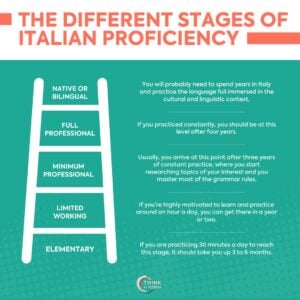What is passive voice?
Take a look at the following two sentences and think about what they mean and how they’re different:
- The prime minister held a conference yesterday.
- A conference was held by the prime minister yesterday.
In the first sentence, the verb is active. Meaning the subject (the prime minister) does the action (held).
In the second sentence, the verb is passive. Meaning the subject of the sentence (a conference) is acted upon.
The first sentence places more emphasis on the prime minister, whereas the second sentence emphasizes the conference.
The passive voice reverses the subject (the doer) and object of action by moving the emphasis away from the doer and more on the action itself.
Let’s have a look at the following sentences:
- When was this school built?
- My car was stolen.
- Horrible things were said about that.
In this sentence, we used the passive because the agent of the action is unknown or impersonal.
We use the passive voice in Italian, too, and luckily it’s very similar to how it is used in English.
Let’s learn more about it!
How to use the passive voice in Italian?
To understand how the passive voice works in Italian, let’s analyze the same idea first using the active voice and then the passive voice:
I miei genitori pagano l’affitto.
My parents pay the rent.
L’affitto è pagato dai miei genitori.
The rent is paid by my parents.
As you can see, we use the verb essere and the past participle of the main verb followed by da (by) or its contractions (dal, dallo, dalla, dai, dagli, dalle).
Essere should be in the same tense as the verb in its corresponding active sentence. And the past participle agrees in gender and number with the subject.
For example, if in the active voice, the verb is in the present, we’ll use the present in the passive voice too.
How to make a verb passive in Italian?
When we use the passive voice in Italian, the verb essere should be conjugated accordingly, depending on what we want to say.
In the following examples, we’ll use the same idea but with different tenses so that you understand the transformation between sentences A (active voice) and sentences B (passive voice).
A: Noi firmiamo il contratto.
A: We sign the contract.
And
B: Il contratto è firmato da noi.
B: The contract is signed by us.
A: Noi abbiamo firmato il contratto.
A: We signed the contract.
And
B: Il contratto è stato firmato da noi.
B: The contract was signed by us.
A: Noi firmavamo il contratto.
A: We signed the contract.
And
B: Il contratto era firmato da noi.
B: The contract was signed by us.
A: Noi firmeremo il contratto.
A: We will sign the contract.
And
B: Il contratto sarà firmato da noi.
B: The contract will be signed by us.
A: Voleva che noi firmassimo il contratto.
A: He wanted us to sign the contract.
And
B: Voleva che il contratto fosse firmato da noi.
B: He wanted the contract to be signed by us.
A: Noi firmeremmo il contratto.
A: We would sign the contract.
And
B: Il contratto sarebbe firmato da noi.
B: The contract would be signed by us.
Practice with Quizlet
Here's a set of flashcards and quizzes to practice this grammar topic.How to form the passive voice without an agent?
Like in English, in Italian, the doer is sometimes unmentioned.
This places more emphasis on the action itself, without concern for who did what.
Here are some examples:
La cena è servita alle 8.
Dinner is served at 8.
Il palazzo è stato costruito venti anni fa.
The building was built twenty years ago.
Le tue cose sono state buttate per sbaglio.
Your stuff was thrown out by mistake.
Riccardo fu tanto amato nella sua vita.
Riccardo was very loved in his life.
Voi sarete sempre benvenuti.
You will always be welcomed.


















